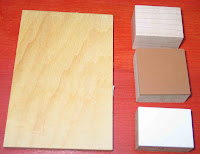"I find that if this instrument made with a screw be well made that is to say, made of linen of which the pores are stopped up with starch..."
These words reminded me of my brother's childhood models of aeroplanes made from balsa wood, covered with doped tissue paper (Biggles anyone?) and also of the aero linen I used to use for bookbinding. Aero linen was the fabric originally used to cover the 'skeleton' of early planes, and was also 'doped' or painted to 'stop up the pores' as Leonardo put it. I understand that the spars forming the skeleton of the plane were bound with strips of linen and the covering of the panels was then stitched to this, and then 'doped' with a solvent based type of varnish. When dry this gave a tough light-weight membrane. Linen is one of the strongest natural fabrics available, and is used in the conservation and repair of books.
After a bit of research I found a supplier of this linen fabric, and may well use it for part of the book, though at the moment I have no idea exactly how.
Aero linen
It is probably quite close to the sort of thing Leonardo was thinking of, a strong, finely woven unbleached linen cloth, to which the early aviators trusted their lives. Charles Anthony Silvestri says in his comments on Eric Whitacre's blog:"It ocurred to me that this was a poem, not historiography, and I was free to compose out of my imagination details of setting and character. It was OK to view this Leonardo as an amalgam of images from books, movies, daydreams-a fabricated, impressionistic Leonardo who exists in an imaginary place and time. This revelation was immensely freeing to me, and I have stayed connected to that freedom."
Similarly, I am really interested in conveying the feelings and images of Leonardo's imaginary dream, I don't wish to reproduce authentic details of fifteenth century Italian life, except in so far as they may contribute to the general picture. Using the linen as a case in point, I would use it to reference the linen that Leonardo may have had in mind, not to reproduce or replicate his drawings in wing form. It would give an idea of just how flimsy the materials were, and how much trust and faith the first aviators had to have in order to put their lives at risk. No wonder Leonardo suggested trying his first flying machine out over water...
And on a different note, I shall be showing some of my books at the Alcuin Vancouver Wayzgoose - printing fair - which will take place on Saturday October 24 in the Vancouver Central Library on West Georgia. See their website for further details. There will also be a presentation by William Rueter on the previous evening in Labatt Hall, SFU on West Hastings, sponsored by the ever-generous Yosef Wosk. Both events are free. To my knowledge the Wayzgoose is the only event of this kind in Western Canada, and it takes place every two years, so be sure not to miss out if you are in the area.






